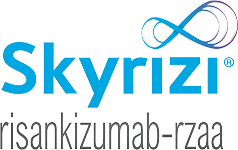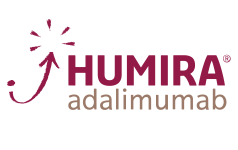HUMIRAⓇ (adalimumab) Dosing
ADMINISTRATION CONSIDERATIONS1
- HUMIRA is administered by subcutaneous (SC) injection
- The first injection should be given under the supervision of a healthcare professional. A patient may self-inject HUMIRA after appropriate training and monitoring by a healthcare professional
- Prior to initiating HUMIRA and periodically during therapy, patients should be evaluated for active tuberculosis and tested for latent infection
- In clinical trials, the most common adverse reaction was injection site reactions. 20% of patients treated with HUMIRA developed injection site reactions (erythema and/or itching, hemorrhage, pain, or swelling), compared to 14% of patients receiving placebo. Most were mild and did not necessitate discontinuation
- Anaphylaxis or serious allergic reactions may occur
ANKYLOSING SPONDYLITIS
Recommended Dose
HUMIRA Prefilled Syringe
40 mg/0.4 mL
NDC: 0074-0243-02
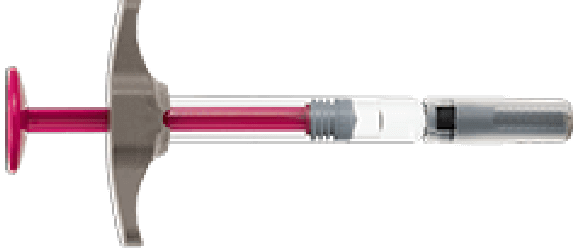
40 mg
Every Other Week
OR
HUMIRA Pen
40 mg/0.4 mL
NDC: 0074-0554-02
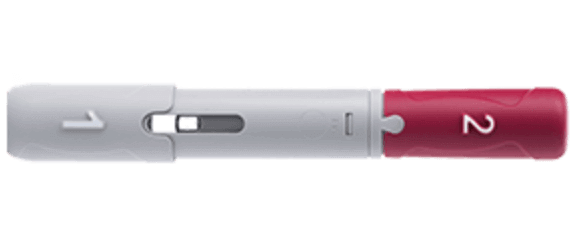
40 mg
Every Other Week
INDICATION1
Ankylosing Spondylitis: HUMIRA is indicated for reducing signs and symptoms in adult patients with active ankylosing spondylitis.
CROHN’S DISEASE (ADULT)
Induction Dose (Adult Crohn's Disease Starter Pack)
HUMIRA Pen 80 mg/0.8 mL
NDC: 0074-0124-03

DAY 1*
2 x 80 mg/0.8 mL (160 mg)

DAY 15
80 mg/0.8 mL
Maintenance Dose Starting at Day 29
HUMIRA Pen 40 mg/0.4 mL
NDC: 0074-0554-02

40 mg/0.4 mL*
Every Other Week
*Administer as two 80-mg injections in 1 day or as one 80-mg injection per day for 2 consecutive days.
- In a maintenance clinical trial, among patients who were not responsive by Week 12, therapy continued beyond 12 weeks did not result in significantly more responses.
INDICATION1
Crohn's Disease: HUMIRA is indicated for the treatment of moderately to severely active Crohn’s disease in adults and pediatric patients 6 years of age and older.
PEDIATRIC CROHN’S DISEASE
SELECT DOSE TYPE
SELECT WEIGHT
Induction Dose (Pediatric Crohn's Disease Starter Pack)
HUMIRA Prefilled Syringe 80 mg/0.8 mL, 40 mg/0.4 mL
NDC: 0074-0067-02

DAY 1
80 mg/0.8 mL

DAY 15
40 mg/0.4 mL
Induction Dose (Pediatric Crohn's Disease Starter Pack)
HUMIRA Pen 80 mg/0.8 mL
NDC: 0074‑0124‑03

DAY 1*
2 x 80 mg/0.8 mL (160 mg)

DAY 15
80 mg/0.8 mL
Also available as a syringe, HUMIRA Prefilled Syringe 80 mg/0.8 mL Pediatric Crohn’s Disease Starter Package NDC: 0074-2540-03.
*Administer as two 80-mg injections in 1 day or as one 80-mg injection per day for 2 consecutive days.
SELECT WEIGHT
Maintenance Dose Starting at Day 29
HUMIRA Prefilled Syringe
20 mg/0.2 mL
NDC: 0074-0616-02
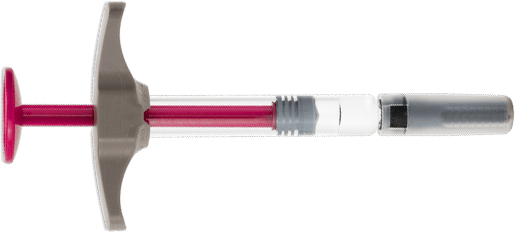
20 mg/0.2 mL
Every Other Week
Maintenance Dose Starting at Day 29
HUMIRA Pen 40 mg/0.4 mL
NDC: 0074-0554-02

40 mg/0.4 mL
Every Other Week
or as a syringe, HUMIRA Prefilled Syringe 40 mg/0.4 mL NDC: 0074‑0243‑02.
INDICATION1
Crohn’s Disease: HUMIRA is indicated for the treatment of moderately to severely active Crohn’s disease in adults and pediatric patients 6 years of age and older.
HIDRADENITIS SUPPURATIVA
Dosing for ADULTS & ADOLESCENTS ≥12 years, ≥60 kg (≥132 lbs)
Initial Doses (HS Starter Pack)
HUMIRA Pen 80 mg/0.8 mL
NDC: 0074-0124-03

DAY 1
2 x 80 mg (160 mg)
or one 80 mg injection on Days 1 and 2

DAY 15
1 x 80 mg
2 Maintenance Doses a Month*

2 WEEKS LATER (Day 29) CONTINUE WITH
1 x 80 mg Every Other Week
HUMIRA Pen 80 mg/0.8 mL (2 Pens)
NDC: 0074-0124-02
Maintenance Dose Starting at Day 29
HUMIRA Pen 40 mg/0.4 mL
4 maintenance doses a month*
NDC: 0074-0554-02

2 WEEKS LATER (Day 29) CONTINUE WITH
1 x 40 mg Every Week
HUMIRA Pen 40 mg/0.4 mL
NDC: 0074-0554-02
*The number of doses per month will vary throughout the year depending on which calendar day a patient begins treatment.
Dosing for ADOLESCENTS ≥12 years, ≥30 kg (66 lbs) to <60 kg (132 lbs)
Induction Dose (Adolescent HS Starter Pack)
HUMIRA Pen 80 mg/0.8 mL (1)
HUMIRA Pen 40 mg/0.4 mL (2)
NDC: 0074-1539-03

DAY 1
1 x 80 mg

DAY 8
1 x 40 mg

DAY 22
1 x 40 mg
2 Maintenance Doses a Month*

2 WEEKS LATER (Day 36) CONTINUE WITH
1 x 40 mg Every Other Week
HUMIRA Pen 40 mg/0.4 mL
NDC: 0074-0554-02
*The number of doses per month will vary throughout the year depending on which calendar day a patient begins treatment.
INDICATION1
Hidradenitis Suppurativa: HUMIRA is indicated for the treatment of moderate to severe hidradenitis suppurativa in patients 12 years of age and older.
HS=hidradenitis suppurativa
JUVENILE IDIOPATHIC ARTHRITIS
HUMIRA Prefilled Syringe 10 mg/0.1 mL
NDC: 0074-0817-02

10 mg
Every Other Week
HUMIRA Prefilled Syringe 20 mg/0.2 mL
NDC: 0074-0616-02

20 mg
Every Other Week
HUMIRA Prefilled Syringe
40 mg/0.4 mL
NDC: 0074-0243-02

40 mg
Every Other Week
OR
HUMIRA Pen
40 mg/0.4 mL
NDC: 0074-0554-02

40 mg
Every Other Week
HUMIRA has not been studied in patients with polyarticular JIA less than 2 years of age or in patients with a weight below 10 kg.
INDICATION1
Juvenile Idiopathic Arthritis: HUMIRA is indicated, alone or in combination with methotrexate, for reducing signs and symptoms of moderately to severely active polyarticular juvenile idiopathic arthritis in patients 2 years of age and older.
PLAQUE PSORIASIS
Plaque Psoriasis Starter Pack (3 count)
HUMIRA Pen 80 mg/0.8 mL (1)
HUMIRA Pen 40 mg/0.4 mL (2)
NDC: 0074-1539-03
DAY
1

80 mg Pen
DAY
8

40 mg Pen
DAY
22

40 mg Pen
2 Maintenance Doses a Month*

1 x 40 mg Every Other Week
HUMIRA Pen 40 mg/0.4 mL (2 pens)
NDC: 0074-0554-02
Every
Other
Week
Maintenance Dose

40 mg Pen
HUMIRA Pen 40 mg/0.4 mL (2)
NDC: 0074-0554-02
INDICATION1
Plaque Psoriasis: HUMIRA is indicated for the treatment of adult patients with moderate to severe chronic plaque psoriasis who are candidates for systemic therapy or phototherapy, and when other systemic therapies are medically less appropriate. HUMIRA should only be administered to patients who will be closely monitored and have regular follow-up visits with a physician.
PSORIATIC ARTHRITIS
Recommended Dose
HUMIRA Prefilled Syringe
40 mg/0.4 mL
NDC: 0074-0243-02

40 mg
Every Other Week
OR
HUMIRA Pen
40 mg/0.4 mL
NDC: 0074-0554-02

40 mg
Every Other Week
INDICATION1
Psoriatic Arthritis: HUMIRA is indicated, alone or in combination with non-biologic DMARDs, for reducing signs and symptoms, inhibiting the progression of structural damage, and improving physical function in adult patients with active psoriatic arthritis.
RHEUMATOID ARTHRITIS
Recommended Dose
HUMIRA Prefilled Syringe
40 mg/0.4 mL
NDC: 0074-0243-02

40 mg
Every Other Week
OR
HUMIRA Pen
40 mg/0.4 mL
NDC: 0074-0554-02

40 mg
Every Other Week
INDICATION1
Rheumatoid Arthritis: HUMIRA is indicated, alone or in combination with methotrexate or other non-biologic DMARDs, for reducing signs and symptoms, inducing major clinical response, inhibiting the progression of structural damage, and improving physical function in adult patients with moderately to severely active rheumatoid arthritis.
DMARD=disease-modifying anti-rheumatic drugs
ULCERATIVE COLITIS (ADULT)
Induction Dose (Starter Pack)
HUMIRA Pen 80 mg/0.8 mL
NDC: 0074-0124-03

DAY 1*
2 x 80 mg/0.8 mL (160 mg)

DAY 15
80 mg/0.8 mL
*Administer as two 80‑mg injections in 1 day or as one 80‑mg injection per day for 2 consecutive days.
Maintenance Dose Starting at Day 29
HUMIRA Pen 40 mg/0.4 mL
NDC: 0074-0554-02

40 mg/0.4 mL
Every Other Week
- Discontinue HUMIRA in adult patients without evidence of clinical remission by 8 weeks (Day 57) of therapy.
INDICATION1
Ulcerative Colitis: HUMIRA is indicated for the treatment of moderately to severely active ulcerative colitis in adults and pediatric patients 5 years of age and older.
Limitations of Use:
The effectiveness of HUMIRA has not been established in patients who have lost response to or were intolerant to TNF blockers.
PEDIATRIC ULCERATIVE COLITIS
SELECT DOSE TYPE
SELECT WEIGHT
Induction Dose
HUMIRA Pen 40 mg/0.4 mL
NDC: 0074-0554-02

DAY 1
2 x 40 mg/0.4 mL (80 mg)*

DAY 8
40 mg/0.4 mL*

DAY 15
40 mg/0.4 mL*
*Dose also available as a HUMIRA Prefilled Syringe 40 mg/0.4 mL NDC: 0074‑0243‑02.
Induction Dose
HUMIRA Pen 80 mg/0.8 mL
Pediatric Ulcerative Colitis Starter Pack
NDC: 0074‑0124‑04

DAY 1*
2 x 80 mg/0.8 mL (160 mg)

DAY 8
80 mg/0.8 mL

DAY 15
80 mg/0.8 mL
SELECT WEIGHT
Maintenance Dose Starting at Day 29
HUMIRA Pen 40 mg/0.4 mL or HUMIRA Prefilled Syringe 20 mg/0.2 mL
NDC: 0074-0554-02 or NDC: 0074-0616-02
Choose One of 2 Ways to Prescribe

40 mg/0.4 mL*
Every Other Week
OR

20 mg/0.2 mL
Every Week
Maintenance Dose Starting at Day 29
HUMIRA Pen 80 mg/0.8 mL or 40 mg/0.4 mL
NDC: 0074-0124-02 or NDC: 0074-0554-02
Choose One of 2 Ways to Prescribe

80 mg/0.8 mL
Every Other Week
OR

40 mg/0.4 mL
Every Week
or HUMIRA Prefilled Syringe 40 mg/0.4 mL
NDC: 0074‑0243‑02
*Administered as two 80‑mg injections in 1 day or as one 80‑mg injection per day for 2 consecutive days.
- Continue the recommended pediatric dosage in patients who turn 18 years of age and who are well-controlled on their HUMIRA regimen.1
INDICATION1
Ulcerative Colitis: HUMIRA is indicated for the treatment of moderately to severely active ulcerative colitis in adults and pediatric patients 5 years of age and older.
Limitations of Use:
The effectiveness of HUMIRA has not been established in patients who have lost response to or were intolerant to TNF blockers.
NON-INFECTIOUS UVEITIS (ADULT)
Initial Doses (Uveitis Starter Pack)
HUMIRA Pen 80 mg/0.8 mL and 40 mg/0.4 mL
NDC: 0074-1539-03
DAY
1

80 mg Pen
DAY
8

40 mg Pen
DAY
22

40 mg Pen
HUMIRA Prefilled Syringe
40 mg/0.4 mL
NDC: 0074-0243-02

40 mg
Every Other Week
OR
HUMIRA Pen
40 mg/0.4 mL
NDC: 0074-0554-02

40 mg
Every Other Week
INDICATION1
Uveitis: HUMIRA is indicated for the treatment of non-infectious intermediate, posterior, and panuveitis in adults.
PEDIATRIC NON-INFECTIOUS UVEITIS
The recommended dose of HUMIRA for pediatric patients 2 years of age and older with NI intermediate, posterior, or panuveitis is based on weight as shown below. MTX, glucocorticoids, NSAIDs, and/or analgesics may be continued during treatment with HUMIRA.
HUMIRA Prefilled Syringe 10 mg/0.1 mL
NDC: 0074-0817-02

10 mg
Every Other Week
HUMIRA Prefilled Syringe 20 mg/0.2 mL
NDC: 0074-0616-02

20 mg
Every Other Week
HUMIRA Prefilled Syringe
40 mg/0.4 mL
NDC: 0074-0243-02

40 mg
Every Other Week
OR
HUMIRA Pen
40 mg/0.4 mL
NDC: 0074-0554-02

40 mg
Every Other Week
- HUMIRA has not been studied in patients with pediatric uveitis less than 2 years of age or in patients with a weight below 10 kg
INDICATION1
Uveitis: HUMIRA is indicated for the treatment of non-infectious intermediate, posterior, and panuveitis in pediatric patients 2 years of age and older.
MTX=methotrexate; NSAID=nonsteroidal anti-inflammatory drug; NI=non-infectious

